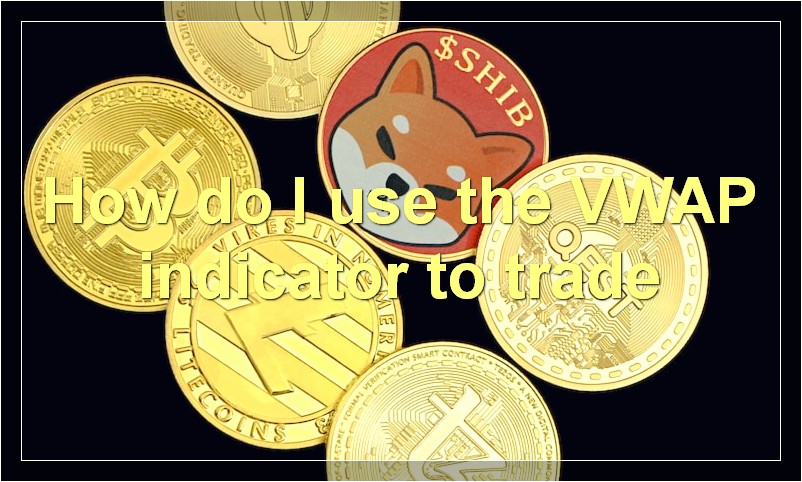If you’re looking for a reliable indicator to help inform your trading decisions, look no further than the VWAP indicator. In this article, we’ll explain what the VWAP indicator is and how you can use it to your advantage.
How do I set up a VWAP indicator on MT4
If you’re looking to add the VWAP indicator to your MT4 chart, here’s a quick and easy guide on how to do it.
First, right click on your chart and select “Indicators” from the drop-down menu.
Scroll down the list of indicators until you find “VWAP” and select it.
Now all you need to do is hit “OK” and the indicator will be added to your chart.
You can customize the settings for the VWAP indicator by right clicking on it and selecting “Properties.” For example, you can change the period length, line width, and line color.
Once you have the VWAP indicator set up the way you want it, you can start using it to help make better trading decisions. For example, you can use it to identify key support and resistance levels, or to time your entries and exits.
How do I use the VWAP indicator to trade

The VWAP indicator is a great tool for traders to use in order to make better trading decisions. This indicator measures the volume weighted average price of a security, and can be used on any time frame. VWAP can be used as a standalone indicator, or in conjunction with other technical indicators. When used correctly, VWAP can help traders find market turning points, identify trends, and make better trading decisions.
What is the difference between VWAP and other moving averages
In general, a moving average (MA) is a calculation that takes the average price of a security over a specific period of time. The most common moving averages are the simple moving average (SMA), which is the average over a certain number of days, and the exponential moving average (EMA), which gives more weight to recent prices.
The VWAP is different in that it considers both the price and volume of a security when calculating the average. This makes it a more accurate measure of the true value of a security, since it takes into account both the price and the amount of shares traded.
While the VWAP is a more accurate measure of value, it can be more difficult to calculate than other moving averages. For this reason, many traders use simpler moving averages, such as the SMA or EMA, when making decisions about where to buy and sell securities.
Why is the VWAP indicator useful
The VWAP indicator is a technical analysis tool that helps traders see the average price of a security over a set period of time. This information can be useful in making trading decisions, as it can give traders an idea of where the market is heading.
How can I incorporate the VWAP indicator into my trading strategy
The VWAP indicator can be a useful tool for traders looking to incorporate volume into their trading strategy. The indicator measures the volume-weighted average price of a security over a given period of time, typically the trading day. VWAP is calculated by adding up all of the prices at which a security traded during the day and dividing by the total number of shares traded.
VWAP can be used as a simple measure of market sentiment. If the VWAP is rising, it indicates that buyers are willing to pay increasingly higher prices for the security, and vice versa if the VWAP is falling. Traders may also use VWAP as a point of reference for placing orders, either to buy or sell at a certain price relative to the VWAP, or as a stop-loss order.
Incorporating VWAP into a trading strategy can help traders make better informed decisions about when to buy and sell a security. However, it is important to remember that VWAP is just one indicator among many, and should not be used in isolation.
What are some common VWAP trading strategies

There are a few different VWAP trading strategies that traders use. Some common ones are:
-Trading with the VWAP: Trying to trade with the overall trend of the market by buying when the VWAP is rising and selling when it is falling.
-Using the VWAP as a support/resistance level: Buying or selling when the price reaches the VWAP and then using it as a target to take profits or stop losses.
-Using multiple VWAPs: Some traders will use multiple VWAPs on different timeframes to help them make trading decisions. For example, they might use a daily VWAP to help them find long-term trends and a shorter-term VWAP to help them find entries and exits for their trades.
How do I interpret the VWAP indicator
The VWAP indicator is a technical analysis tool that measures the volume-weighted average price of a security over a given period of time. In other words, it shows you the average price that investors are paying for a security, based on the amount of shares traded.
VWAP can be used to measure the overall market sentiment, as well as to identify buying and selling pressure. It can also be used as a support or resistance level.
If you’re looking at a chart with VWAP, you’ll typically see three lines:
– The blue line is the VWAP itself.
– The yellow line is the standard deviation of the VWAP. This is used to show how far away from the VWAP price is currently trading.
– The red line is the mean price, which is simply the average price over the given period of time.
To interpret the VWAP indicator, you need to understand what each of these lines represent.
The blue line is the most important, as it shows you the volume-weighted average price. This is a good indicator of where the market is currently trading. If price is above the VWAP, it suggests that buyers are in control and prices are likely to continue to rise. If price is below the VWAP, it suggests that sellers are in control and prices are likely to fall.
The yellow line represents the standard deviation of the VWAP. This helps to show how far away from the VWAP price is currently trading. If the standard deviation is large, it means that price is volatile and could move in either direction. If the standard deviation is small, it means that price is relatively stable and is unlikely to make big moves in either direction.
The red line represents the mean price, which is simply the average price over the given period of time. This line isn’t as important as the others, but it can be helpful in spotting trends. If prices are consistently above or below the mean price, it could be an indication that a trend is developing.
What are the limitations of the VWAP indicator
There are a few potential limitations of using the VWAP indicator, which include:
1. The VWAP indicator only applies to trading during regular market hours. If you are trading outside of regular market hours, the VWAP may not be an accurate measure.
2. The VWAP indicator is based on the volume traded at each price level. If there is low volume traded at a certain price level, the VWAP may not be an accurate measure.
3. The VWAP indicator is a lagging indicator, which means it will only provide information after the fact. This can make it difficult to use the VWAP as a predictive tool.
Is the VWAP indicator reliable
There are many different ways to measure the average price of a security, and the volume-weighted average price (VWAP) is just one method. While the VWAP indicator can be a useful tool for day traders, it’s not necessarily the most reliable indicator out there. Here’s a closer look at why that is and some alternative ways to measure the average price.
The biggest problem with the VWAP indicator is that it relies on historical data, which isn’t always accurate. For example, if there was a sudden spike in trading volume during a particular period, the VWAP would be skewed higher as a result. This could lead to false signals if you’re using the VWAP as a buy or sell signal.
Another issue with the VWAP is that it doesn’t take into account the time of day. This means that the VWAP could be different at different times of the day, which makes it less reliable as a consistent measure.
If you’re looking for a more reliable way to measure the average price of a security, you might want to consider using the Simple Moving Average (SMA) instead. The SMA is less affected by spikes in volume and it takes into account the time of day, so it’s a more accurate measure of the average price.
What are some other ways to use the VWAP indicator
There are a few other ways that the VWAP indicator can be used. One way is to use it as a target for taking profits. This can be done by selling when the price moves above the VWAP, or buying when the price moves below the VWAP. Another way to use the VWAP indicator is to use it as a support or resistance level. This can be done by looking for price reversals around the VWAP level.

